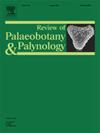Yalvaç 盆地(土耳其安纳托利亚中部)的晚中新世水生植物群:生物地层学和古生态学
IF 1.7
3区 地球科学
Q2 PALEONTOLOGY
引用次数: 0
摘要
本文首次描述并展示了雅尔瓦奇盆地(土耳其安纳托利亚中部)上新世沉积物中的水生植物果实和种子(8 个叶绿体物种和 5 个种子/果实)。该植物群是从以下两个地方采集的:巴尔奇村附近厚度为 39 米的沉积序列,主要是与发育良好的碱性深湖有关的灰岩;Şarkikaraağaç 村附近厚度为 252 米的钻孔(SK-2),主要是有机粘土岩和泥灰岩,形成于浅滩和浅湖条件下。这两个地层都属于 Göksöğüt 地层(上新世-上新世)。Balcı 的组合主要由 Sphaerochara cf. intricata、Chara vulgaris、Chara cf. aspera、Lychnothamnus duplicicarinatus 和 Lychnothamnus cf. barbatus subsp.Şarkikaraağaç的SK-2钻孔下部出土的石龙子种类繁多,保存完好。采集的矿物包括 Sphaerochara intricata、Chara vulgaris、Chara globularis、Chara cf. hispida、Chara cf. aspera、Nitellopsis (Tectochara) etrusca 和 Lychnothamnus duplicicarinatus。一些水生植物和轮叶植物的种子/果实与叶绿素植物群落有关,包括 Ceratophyllum、Aldrovanda、Scirpus、Ranunculus 和 Typha。N. (T.) etrusca物种的优势表明,萨尔基卡拉阿克沉积序列的基底是中新世晚期,很可能是瓦利斯-图罗里安时期。同样,巴尔奇沉积层底部出现的 Lychnothamnus cf. barbatus subsp.Balcı 剖面和 SK-2 钻孔中的面层组合和相关化石(如浮游动物)表明,在中新世晚期,雅尔瓦奇盆地普遍存在着湖泊和湖泊条件。盆地中部的湖泊是稳定的、低营养和低盐湖,而湖泊边缘的地下水位则有所波动,那里普遍存在着湖泊植被条件。N. (T.) etrusca 和 L. duplicicarinatus 以及 L. barbatus subsp.本文章由计算机程序翻译,如有差异,请以英文原文为准。
Late Miocene aquatic flora from the Yalvaç Basin (Central Anatolia, Türkiye): Biostratigraphy and paleoecology
An assemblage of fructifications and seeds of aquatic plants (8 charophyte species and 5 seeds/fruits) from upper Miocene deposits of the Yalvaç Basin (Central Anatolia, Türkiye) is described and illustrated here for the first time. This flora has been recovered from 2 localities: a 39 m-thick sedimentary sequence near the village of Balcı, dominated by limestones related to well-developed, alkaline, and deep lake; and a 252 m-thick borehole (SK–2) near the village of Şarkikaraağaç, dominated by organic claystones and marls formed in a context of palustrine and shallow lake conditions. Both sequences are within the Göksöğüt Formation (upper Miocene–Pliocene). The assemblage at Balcı is dominated by gyrogonites of the genus Sphaerochara cf. intricata, Chara vulgaris, Chara cf. aspera, Lychnothamnus duplicicarinatus, and Lychnothamnus cf. barbatus subsp. megalicarpus. Gyrogonites from the lower part of the SK–2 borehole at Şarkikaraağaç are very diverse and well-preserved. The assemblage is composed of Sphaerochara intricata, Chara vulgaris, Chara globularis, Chara cf. hispida, Chara cf. aspera, Nitellopsis (Tectochara) etrusca, and Lychnothamnus duplicicarinatus. Several seeds/fruits of aquatic and helophytic plants occur associated with this charophyte flora, including Ceratophyllum, Aldrovanda, Scirpus, Ranunculus and Typha. The dominance of the species N. (T.) etrusca suggests that the base of the sedimentary sequence at Şarkikaraağaç is late Miocene, most probably Vallesian-Turolian in age. Likewise, the occurrence of Lychnothamnus cf. barbatus subsp. megalicarpus at the base of the Balcı sequence indicates that it probably dates back to the Turolian age. The facies assemblage and the associated fossils such as ostracods from both Balcı section and the SK–2 borehole indicate that palustrine and lacustrine conditions prevailed in the Yalvaç Basin during the late Miocene. The lake was stable, oligotrophic and oligohaline in the central part of the basin, while the water table fluctuated along the lake's edges where palustrine vegetated conditions prevailed. The species N. (T.) etrusca and L. duplicicarinatus and L. barbatus subsp. megalicarpus are being reported for the first time in Anatolia, providing significant information about the distributional pattern of these biostratigraphically significant taxa.
求助全文
通过发布文献求助,成功后即可免费获取论文全文。
去求助
来源期刊
CiteScore
3.50
自引率
21.10%
发文量
149
审稿时长
6 months
期刊介绍:
The Review of Palaeobotany and Palynology is an international journal for articles in all fields of palaeobotany and palynology dealing with all groups, ranging from marine palynomorphs to higher land plants. Original contributions and comprehensive review papers should appeal to an international audience. Typical topics include but are not restricted to systematics, evolution, palaeobiology, palaeoecology, biostratigraphy, biochronology, palaeoclimatology, paleogeography, taphonomy, palaeoenvironmental reconstructions, vegetation history, and practical applications of palaeobotany and palynology, e.g. in coal and petroleum geology and archaeology. The journal especially encourages the publication of articles in which palaeobotany and palynology are applied for solving fundamental geological and biological problems as well as innovative and interdisciplinary approaches.

 求助内容:
求助内容: 应助结果提醒方式:
应助结果提醒方式:


